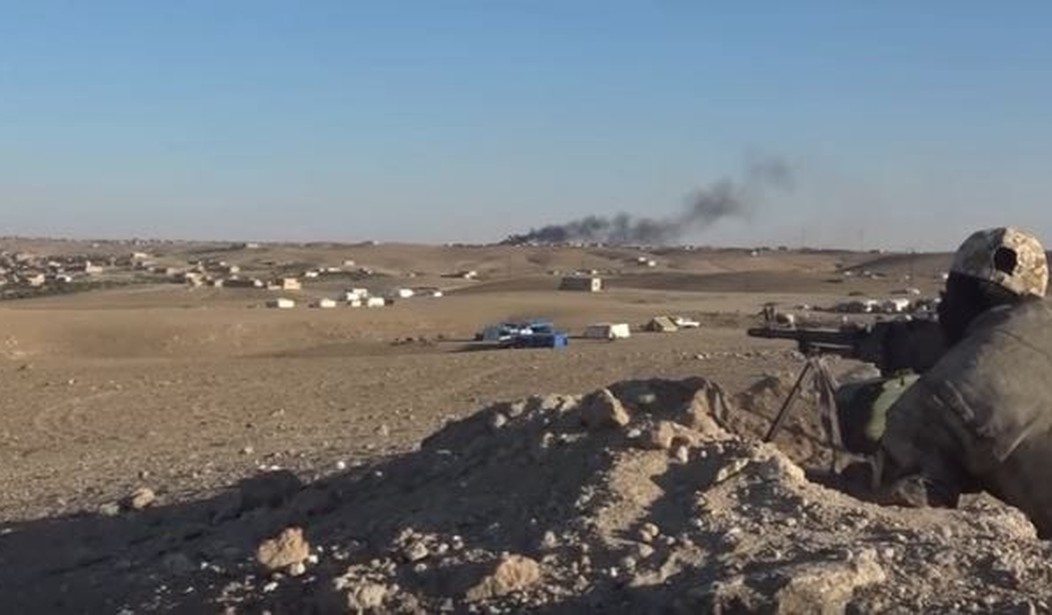A senior advisor to Chairman of the Joint Chiefs of Staff Gen. Joe Dunford gave his boss a glowing a review of the discipline, training and morale of the multi-sectarian, multi-ethnic fighting coalition currently bearing down on ISIS’ capital in Syria.
The Syrian Democratic Forces — an anti-ISIS, anti-Qaeda, anti-Assad coalition composed of more than 50,000 fighters, female and male commanders, Arabs, Assyrian Christians, Kurds, and other minority ethnic groups — launched the Wrath of Euphrates operation at the beginning of November. Since then, the SDF has liberated more than 5,000 square miles of territory in the painstaking push to encircle and choke off Raqqa before moving in.
This week, the SDF liberated towns on the outskirts of al-Tabqa, a city 35 miles west of Raqqa, and now have the city surrounded. That included careful fighting around a booby-trapped dam on the Euphrates — and some scare tactics from ISIS to try to stop the assault.
Nice SDF vid of today for all the ones screaming Tabqa dam was damaged badly & could fall down every moment. It was just another daesh stunt pic.twitter.com/T1FE6795zF
— Rojava (@AzadiRojava) April 5, 2017
Dunford, who was in Iraq this week along with White House senior advisor Jared Kushner, sent Army Command Sgt. Maj. John Wayne Troxell to visit U.S. special forces on the ground in Syria and the SDF.
Troxell “got to see the Syrian Democratic Forces in action — both training and on security,” he told DoD News, and found unanimous sentiment that “our forces just had absolute confidence in the SDF.”
The U.S. is supporting the SDF from the air and with Marine artillery and Army high-mobility artillery rocket systems. Troxell said the Marines have been in Syria “a little over a month and had 1,182 fire missions.”
“I walked away with the utmost confidence that the Syrian Democratic Forces can get the job done,” he said. Troops ranged from their late teens through 20s, with older leaders and “small-unit leadership.”
“You could tell they have a good [command] climate, that commanders are engaged and they are a disciplined force,” Troxell added. “Talking to some of our special operators, in their opinion, [the SDF] was some of the best partnered forces they have ever been with… Many of them have family in Raqqa and they want to go now, but understand they have to prepare the battlefield in order to have success.”
The SDF has reported picking up new fighters, men and women, in towns that they liberate along the path to Raqqa. Troxell viewed training drills during his visit.
The Dunford aide also noted that the SDF and the Americans get along well.
“Wherever the Americans went they had SDF with them,” he said. “I wasn’t told of any frictions between them. There is unity of command in how they do business, and of course we are advising and assisting and accompanying, and the SDF is doing the fighting, and leaders said they were pleased with the progress.”
Troxell said he didn’t see didn’t see an SDF that was “starving for advisors,” but stressed that more American advisors on the ground would be an asset.
About 1,000 of the fighters directly involved in the campaign to retake Raqqa are women, according to the SDF, including Kurdish SDF General Commander Rojda Felat.
Felat told Reuters a week ago that the SDF entrance into Raqqa will take place this month, but the fight is expected to “last for a number of months, because it requires us to completely control Tabqa firstly, and to organize the campaign plans very well, and to get civilians out of the city.”
She said American advisors have been positioned “behind our frontline forces, 2 or 3 km away” and the U.S. has been offering better support “such as using heavy and medium weapons, anti-armor weapons and artillery” and intelligence cooperation.
Felat, who lost 20 members of her family in an ISIS bombing last year, has repeatedly voiced her goal of liberating the ISIS sex slaves held in Raqqa.









Join the conversation as a VIP Member